ভূমিকা
আমাদের বিস্তারিত নির্দেশিকায় স্বাগতম শীট মেটাল রোল ফর্মিং মেশিন। এই নিবন্ধে আমরা এই মেশিনগুলির বিভিন্ন দিক নিয়ে আলোচনা করব, যার মধ্যে রয়েছে তাদের কার্যপ্রণালী, সুবিধা, প্রয়োগ এবং আরও অনেক কিছু। শীট মেটাল রোল ফর্মিং মেশিনগুলি উৎপাদন শিল্পে গুরুত্বপূর্ণ ভূমিকা পালন করে, যা জটিল আকার এবং প্রোফাইলের ধাতব উপাদান দক্ষ এবং খরচ-সাশ্রয়ীভাবে উৎপাদনের সক্ষমতা প্রদান করে। আপনি যদি রোল ফর্মিংয়ে নতুন হন বা জ্ঞান সমৃদ্ধ করতে চান, তাহলে এই নিবন্ধটি এই আকর্ষণীয় প্রযুক্তি সম্পর্কে মূল্যবান অন্তর্দৃষ্টি প্রদান করবে।
শীট মেটাল রোল ফর্মিং মেশিন কী?
শীট মেটাল রোল ফর্মিং মেশিন হলো একটি বিশেষায়িত সরঞ্জাম যা সমতল ধাতব শীটগুলিকে পছন্দসই প্রোফাইল বা ক্রস-সেকশনে রূপান্তরিত করার জন্য ব্যবহৃত হয়। এটি একটি অবিরত বাঁকানো প্রক্রিয়া ব্যবহার করে, যেখানে ধাতব শীটটি একাধিক রোলারের মধ্য দিয়ে অগ্রসর হয়ে ধীরে ধীরে আকার লাভ করে। রোলার কনফিগারেশন এবং সমন্বয় সতর্কতার সাথে নিয়ন্ত্রণ করে, উৎপাদকরা উচ্চ নির্ভুলতা এবং সামঞ্জস্যের সাথে বিভিন্ন জটিল আকার এবং প্রোফাইল উৎপাদন করতে পারেন।
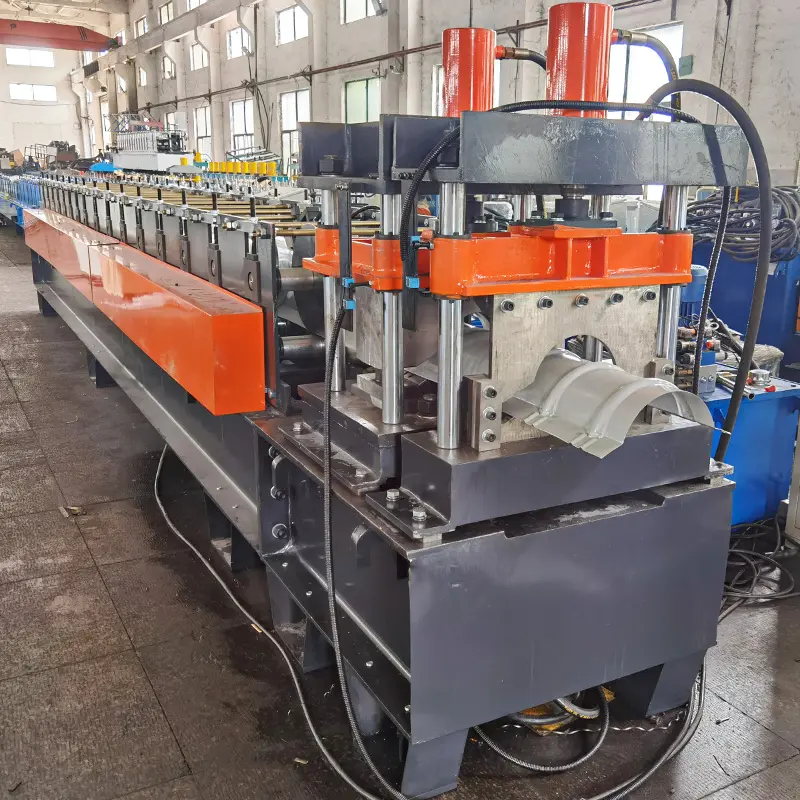
শীট মেটাল রোল ফর্মিং মেশিন ব্যবহারের সুবিধাসমূহ
৩.১ দক্ষতা এবং উৎপাদনশীলতা বৃদ্ধি
শীট মেটাল রোল ফর্মিং মেশিন ব্যবহারের প্রধান সুবিধাগুলির মধ্যে একটি হলো এর দ্বারা প্রদত্ত উল্লেখযোগ্য দক্ষতা এবং উৎপাদনশীলতা বৃদ্ধি। ঐতিহ্যগত ফ্যাব্রিকেশন পদ্ধতিগুলির বিপরীতে যা একাধিক ধাপ এবং অপারেশনের প্রয়োজন হয়, রোল ফর্মিং অবিরত এবং স্বয়ংক্রিয় পদ্ধতিতে সমাপ্ত অংশ উৎপাদন করতে পারে। এটি ম্যানুয়াল হ্যান্ডলিংয়ের প্রয়োজনীয়তা দূর করে এবং উৎপাদন সময় কমিয়ে, উচ্চতর আউটপুট হার এবং সামগ্রিক দক্ষতা বাড়ায়।
৩.২ খরচ-সাশ্রয়ী উৎপাদন প্রক্রিয়া
শীট মেটাল রোল ফর্মিং একটি খরচ-সাশ্রয়ী উৎপাদন প্রক্রিয়া, বিশেষ করে বৃহৎ পরিসরের উৎপাদনের জন্য। রোল ফর্মিংয়ের স্বয়ংক্রিয় প্রকৃতি শ্রম খরচ কমায় এবং দক্ষ অপারেটরদের উপর নির্ভরতা হ্রাস করে। এছাড়া, এই প্রক্রিয়া ওয়েল্ডিং বা রিভেটিংয়ের মতো সেকেন্ডারি অপারেশনের প্রয়োজনীয়তা দূর করে, যা সামগ্রিক উৎপাদন খরচ আরও কমায়। শীট মেটাল রোল ফর্মিং মেশিন ব্যবহার করে উৎপাদকরা উচ্চমানের আউটপুট বজায় রেখে খরচ সাশ্রয় করতে পারেন।
৩.৩ বহুমুখী এবং কাস্টমাইজযোগ্য ডিজাইন
শীট মেটাল রোল ফর্মিং মেশিনগুলি বিভিন্ন আকার এবং প্রোফাইল ডিজাইন ও উৎপাদনে অসাধারণ বহুমুখিতা প্রদান করে। মেশিনের নমনীয়তা নির্দিষ্ট প্রকল্পের প্রয়োজনীয়তা অনুসারে কাস্টমাইজেশনের সুযোগ দেয়। সহজ প্রোফাইল হোক বা জটিল ডিজাইন, রোল ফর্মিং বিস্তৃত আকার এবং মাপ সামলাতে পারে, যা উৎপাদকদের বৈচিত্র্যময় গ্রাহকের চাহিদা পূরণে সক্ষম করে।
৩.৪ উন্নত উপাদানের শক্তি এবং স্থায়িত্ব
রোল ফর্মিং শুধু ধাতুকে আকার দেয় না, বরং এর কাঠামোগত অখণ্ডতাকেও উন্নত করে। অবিরত বাঁকানো প্রক্রিয়া ধাতুতে শক্তি এবং স্থায়িত্ব প্রদান করে, যা কঠিন অ্যাপ্লিকেশনের জন্য উপযুক্ত করে তোলে। ফর্মিং প্যারামিটারগুলির নির্ভুল নিয়ন্ত্রণের মাধ্যমে উৎপাদকরা উপাদানের বৈশিষ্ট্য অপ্টিমাইজ করতে এবং উৎপাদন প্রক্রিয়ার সম্পূর্ণতায় সামঞ্জস্যপূর্ণ গুণমান নিশ্চিত করতে পারেন।
৩.৫ কম বর্জ্য এবং পরিবেশগত প্রভাব
শীট মেটাল রোল ফর্মিং মেশিন একটি অত্যন্ত দক্ষ প্রক্রিয়া যা অন্যান্য ফ্যাব্রিকেশন পদ্ধতির তুলনায় সামান্য বর্জ্য উৎপন্ন করে। ধাতুর শীটের নির্ভুল আকার দেওয়া এবং বাঁকানো উপাদানের ক্ষতি কমিয়ে দেয়, ফলে কম স্ক্র্যাপ হয়। এছাড়া, রোল ফর্মিং মেশিনগুলি পুনর্ব্যবহৃত বা প্রি-কোটেড উপাদান ব্যবহার করতে পারে, যা পরিবেশগত প্রভাব আরও কমায় এবং টেকসইতা প্রচার করে।
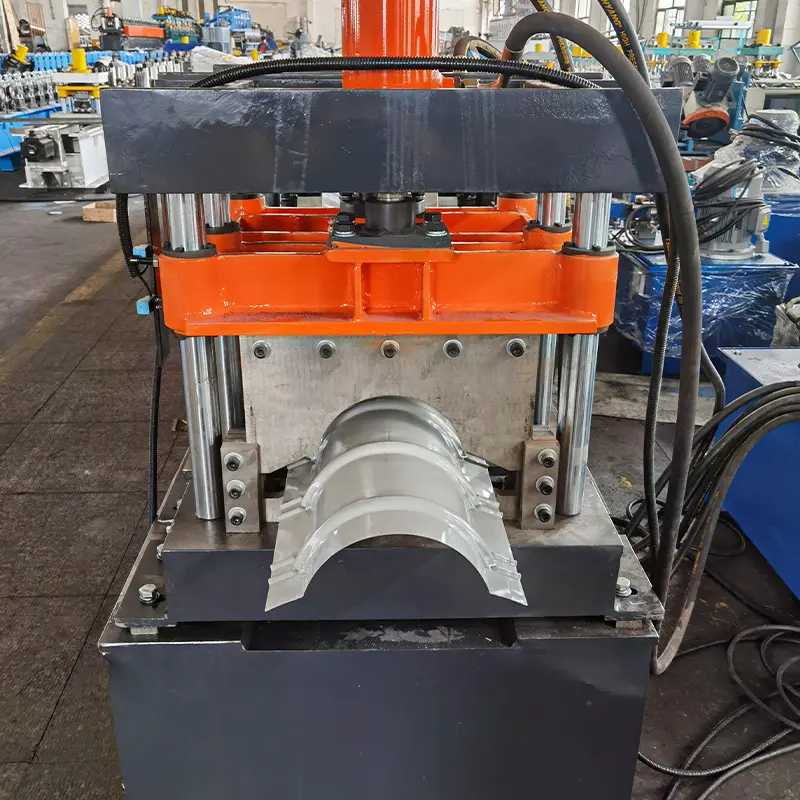
শীট মেটাল রোল ফর্মিং মেশিনের বিভিন্ন ধরন
বিভিন্ন অ্যাপ্লিকেশন এবং উৎপাদন প্রয়োজনীয়তার জন্য বিভিন্ন ধরনের শীট মেটাল রোল ফর্মিং মেশিন উপলব্ধ। আসুন কিছু সাধারণ ধরন নিয়ে আলোচনা করি:
৪.১ সিঙ্গেল-সাইড রোল ফর্মিং মেশিন
একতরফা রোল ফর্মিং মেশিনটি ধাতুর শীটকে একদিক থেকে শুধুমাত্র বাঁকায়। এটি সামঞ্জস্যপূর্ণ ক্রস-সেকশনযুক্ত সাধারণ প্রোফাইল উৎপাদনের জন্য উপযুক্ত।
৪.২ ডাবল-সাইড রোল ফর্মিং মেশিন
দ্বিতরফা রোল ফর্মিং মেশিনটি ধাতুর শীটকে উভয় দিক থেকে একই সাথে বাঁকাতে পারে। এটি অসমমিত আকৃতির আরও জটিল প্রোফাইল উৎপাদনে সক্ষম করে।
৪.৩ ডুপ্লেক্স রোল ফর্মিং মেশিন
ডুপ্লেক্স রোল ফর্মিং মেশিনে দুটি রোল ফর্মিং ইউনিট সমান্তরালভাবে স্থাপিত থাকে। এটি দুটি ভিন্ন প্রোফাইলের একই সাথে উৎপাদন সক্ষম করে, যা উৎপাদনশীলতা বাড়ায় এবং উৎপাদন সময় কমায়।
৪.৪ অটোমেটিক রোল ফর্মিং মেশিন
অটোমেটিক রোল ফর্মিং মেশিনে উন্নত নিয়ন্ত্রণ সিস্টেম রয়েছে যা সম্পূর্ণ উৎপাদন প্রক্রিয়া স্বয়ংক্রিয় করে। এটি ম্যানুয়াল অ্যাডজাস্টমেন্টের প্রয়োজনীয়তা দূর করে এবং উচ্চ-গতি এবং নির্ভুল উৎপাদন সক্ষম করে।
৪.৫ সিএনসি রোল ফর্মিং মেশিন
সিএনসি (কম্পিউটার নিউমেরিকাল কন্ট্রোল) রোল ফর্মিং মেশিন কম্পিউটার প্রোগ্রাম দ্বারা নিয়ন্ত্রিত, যা উন্নত নির্ভুলতা এবং কাস্টমাইজেশন প্রদান করে। এটি জটিল প্রোফাইল এবং জটিল ডিজাইন উৎপাদন করতে পারে, যা সবচেয়ে কঠিন স্পেসিফিকেশন পূরণ করে।
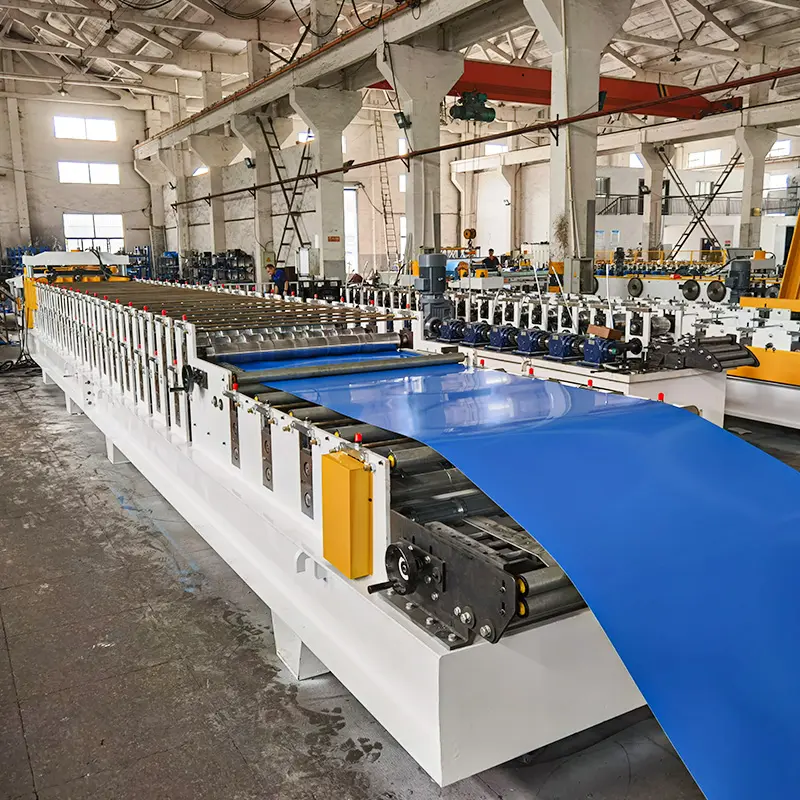
মূল উপাদান এবং কার্যনীতি
শীট মেটাল রোল ফর্মিং মেশিনে বিভিন্ন মূল উপাদান রয়েছে যা একসাথে কাজ করে ধাতুর শীটকে আকার দেয়। আসুন এই উপাদানগুলি এবং তাদের কার্যনীতি নিয়ে আলোচনা করি:
৫.১ এন্ট্রি সেকশন
শীট মেটাল রোল ফর্মিং মেশিনের এন্ট্রি সেকশন হলো সেই স্থান যেখানে ধাতুর শীট প্রক্রিয়াকরণের জন্য মেশিনে প্রবেশ করে। এতে প্রায়শই একটি ডিকয়লার রয়েছে, যা ধাতুর কয়েল ধরে রাখে এবং মেশিনে সরবরাহ করে। ডিকয়লার ধাতুর শীট খুলে দেয় এবং রোল ফর্মিং প্রক্রিয়ার জন্য অবিরত সরবরাহ প্রদান করে।
৫.২ ফর্মিং সেকশন
ফর্মিং সেকশন হলো রোল ফর্মিং মেশিনের হৃদয়স্থল, যেখানে ধাতুর শীট আকার পায় এবং বাঁকায়। এতে একাধিক রোলারের সিরিজ রয়েছে যা শীটকে ধীরে ধীরে কাঙ্ক্ষিত প্রোফাইলে রূপান্তরিত করে। রোলারগুলি সতর্কতার সাথে অবস্থাপিত এবং প্রোফাইলের নির্ভুল মাত্রা এবং আকার অর্জনের জন্য অ্যাডজাস্ট করা যায়।
৫.৩ কাটিং বিভাগ
ধাতু পাত যখন কাঙ্ক্ষিত প্রোফাইলে গঠিত হয়, তখন কাটিং বিভাগ কার্যকর হয়। এই বিভাগে কাটিং টুলস বা শিয়ারিং প্রক্রিয়া অন্তর্ভুক্ত থাকে যা প্রোফাইলটিকে প্রয়োজনীয় দৈর্ঘ্যে কেটে ফেলে। কাটিং প্রক্রিয়া রোল ফর্মিং মেশিনের গতির সাথে সমন্বিত হয় যাতে সঠিক এবং সামঞ্জস্যপূর্ণ কাটিং নিশ্চিত হয়।
৫.৪ প্রস্থান বিভাগ
প্রস্থান বিভাগ রোল ফর্মিং প্রক্রিয়ার সমাপ্তি নির্দেশ করে। এতে মেশিন থেকে নির্গত সমাপ্ত প্রোফাইলগুলোকে সমর্থন এবং সংগ্রহ করার প্রক্রিয়া অন্তর্ভুক্ত থাকে। উৎপাদনের প্রয়োজন অনুসারে, ছিদ্র স্থাপন, এমবসিং বা নচিংয়ের মতো অতিরিক্ত কাজ প্রস্থান বিভাগে একীভূত করা যেতে পারে যাতে প্রোফাইলগুলোতে আরও বৈশিষ্ট্য বা কার্যকারিতা যুক্ত হয়।
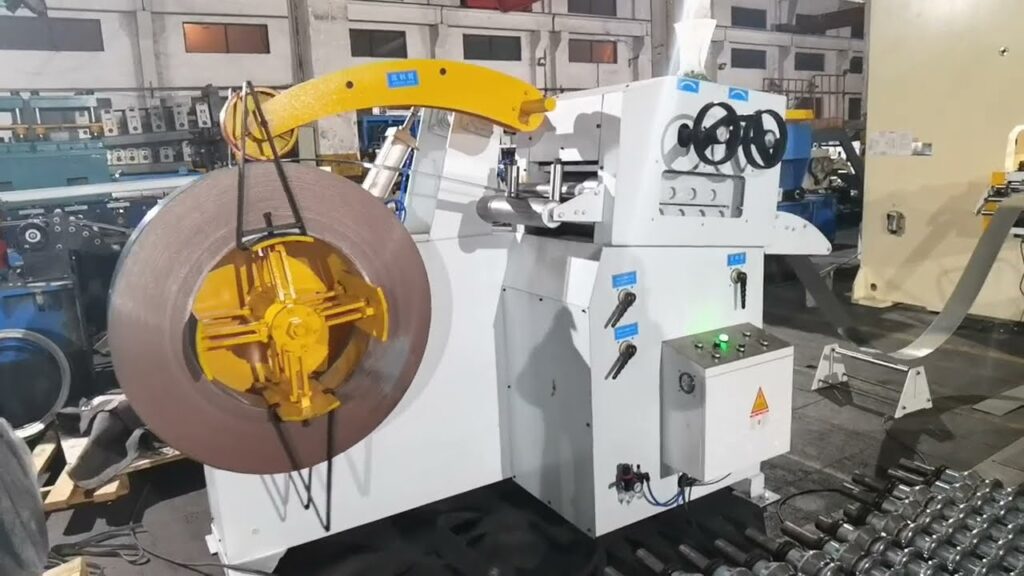
শীট মেটাল রোল ফর্মিং মেশিনের প্রয়োগ
শীট মেটাল রোল ফর্মিং মেশিন বিভিন্ন শিল্পে ব্যাপক প্রয়োগ পায়। আসুন রোল ফর্মিং প্রযুক্তির সাধারণত ব্যবহৃত কয়েকটি মূল খাত অন্বেষণ করি:
৬.১ নির্মাণ শিল্প
নির্মাণ শিল্পে শীট মেটাল রোল ফর্মিং মেশিনগুলো ছাদের প্যানেল, দেয়ালের কভারিং, গাটার সিস্টেম এবং ফ্রেমিং প্রোফাইলের মতো উপাদান উৎপাদনে ব্যবহৃত হয়। কাস্টমাইজড আকার এবং আকার তৈরির ক্ষমতা রোল ফর্মিংকে সুনির্দিষ্ট এবং টেকসই ধাতু উপাদান প্রয়োজনীয় নির্মাণ প্রকল্পের জন্য আদর্শ করে তোলে।
৬.২ অটোমোবাইল শিল্প
অটোমোবাইল 제조কারীরা শীট মেটাল রোল ফর্মিং মেশিনের উপর নির্ভর করে দেহের প্যানেল, চ্যাসিস উপাদান এবং কাঠামোগত শক্তিবৃদ্ধির মতো বিস্তৃত অটোমোবাইল অংশ উৎপাদন করে। রোল-ফর্মড প্রোফাইলের উচ্চ-শক্তি এবং সামঞ্জস্যপূর্ণ গুণমান যানবাহনের নিরাপত্তা এবং কর্মক্ষমতায় অবদান রাখে।
৬.৩ এইচভিএসি শিল্প
এইচভিএসি (হিটিং, ভেন্টিলেশন এবং এয়ার কন্ডিশনিং) শিল্পে ডাক্তিংওয়ার্ক, বায়ু বিতরণ সিস্টেম এবং এইচভিএসি সরঞ্জামের এনক্লোজারের জন্য রোল-ফর্মড উপাদান ব্যাপকভাবে ব্যবহৃত হয়। রোল ফর্মিং সুনির্দিষ্ট মাপ এবং জটিল নকশার ডাক্ট উৎপাদন সক্ষম করে, যা দক্ষ বায়ু প্রবাহ এবং তাপমাত্রা নিয়ন্ত্রণ নিশ্চিত করে।
৬.৪ আসবাবপত্র শিল্প
আসবাবপত্র শিল্পে রোল ফর্মিং মেশিনগুলো ক্যাবিনেট, শেলভিং সিস্টেম, ডেস্ক এবং চেয়ারের জন্য ধাতুর উপাদান উৎপাদনে ব্যবহৃত হয়। অনন্য প্রোফাইল এবং সজ্জাসংক্রান্ত নকশা তৈরির ক্ষমতা আসবাবপত্র পণ্যে সৌন্দর্য এবং কার্যকারিতা যুক্ত করে।
৬.৫ ইলেকট্রিকাল শিল্প
শীট মেটাল রোল ফর্মিং মেশিনগুলো ইলেকট্রিকাল শিল্পে ইলেকট্রিকাল এনক্লোজার, ক্যাবল ট্রে এবং কন্ডুইট সিস্টেম উৎপাদনে ব্যাপকভাবে ব্যবহৃত হয়। রোল-ফর্মড প্রোফাইলের সঠিক এবং সামঞ্জস্যপূর্ণ মাপ ইলেকট্রিকাল সরঞ্জাম এবং তারের সঠিক ফিট এবং সুরক্ষা নিশ্চিত করে।
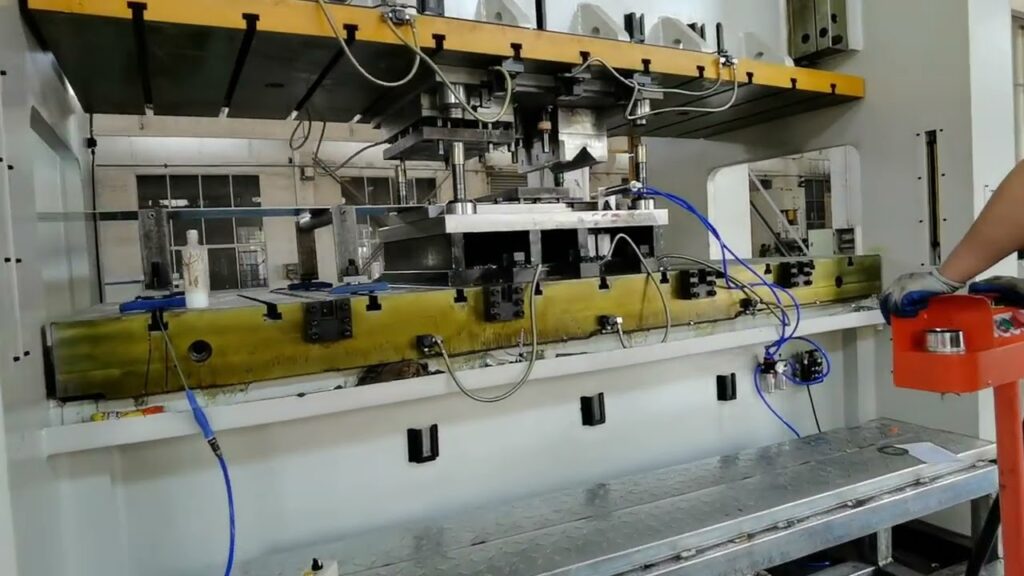
শীট মেটাল রোল ফর্মিং মেশিন নির্বাচনের সময় বিবেচ্য উপাদানসমূহ
শীট মেটাল রোল ফর্মিং মেশিন নির্বাচনের সময় আপনার উৎপাদনের চাহিদার সাথে সেরা মিল নিশ্চিত করার জন্য কয়েকটি উপাদান বিবেচনা করা উচিত। এখানে কয়েকটি মূল উপাদান উল্লেখ করা হলো:
৭.১ উপাদানের পুরুত্ব এবং প্রস্থ
বিভিন্ন রোল ফর্মিং মেশিনের ধাতু পাতের সর্বোচ্চ পুরুত্ব এবং প্রস্থ প্রক্রিয়াকরণের ক্ষমতা ভিন্ন হয়। আপনার উৎপাদনের জন্য প্রয়োজনীয় নির্দিষ্ট উপাদানের মাপ সামলাতে পারে এমন একটি মেশিন নির্বাচন করা অত্যন্ত গুরুত্বপূর্ণ।
৭.২ উৎপাদন গতি এবং ক্ষমতা
রোল ফর্মিং মেশিনের উৎপাদন গতি এবং ক্ষমতা আপনার উৎপাদন প্রক্রিয়ার আউটপুট হার এবং সামগ্রিক দক্ষতা নির্ধারণ করে। কাঙ্ক্ষিত উৎপাদন পরিমাণ বিবেচনা করে আপনার প্রয়োজনীয় গতি এবং ক্ষমতার স্পেসিফিকেশন পূরণ করতে পারে এমন একটি মেশিন নির্বাচন করুন।
৭.৩ মেশিনের নমনীয়তা এবং কাস্টমাইজেশন
বিভিন্ন প্রোফাইল এবং নকশা উৎপাদনের ক্ষমতার দিক থেকে রোল ফর্মিং মেশিনের নমনীয়তা মূল্যায়ন করুন। সহজ টুলিং পরিবর্তন এবং সমন্বয় সুবিধা প্রদানকারী মেশিনগুলো খুঁজুন যাতে বিভিন্ন পণ্যের চাহিদা পূরণ করা যায়।
৭.৪ রক্ষণাবেক্ষণ এবং সহায়তা
রোল ফর্মিং মেশিনের রক্ষণাবেক্ষণের প্রয়োজনীয়তা এবং 제조কারীর কাছ থেকে প্রযুক্তিগত সহায়তার প্রাপ্যতা বিবেচনা করুন। নিয়মিত রক্ষণাবেক্ষণ মেশিনের সর্বোত্তম কর্মক্ষমতা এবং দীর্ঘায়ু নিশ্চিত করে, যখন নির্ভরযোগ্য সহায়তা যেকোনো অপারেশনাল সমস্যা দক্ষতার সাথে সমাধান করতে সাহায্য করে।
৭.৫ খরচ এবং বিনিয়োগের প্রত্যাবর্তন
রোল ফর্মিং মেশিনের প্রাথমিক বিনিয়োগ খরচ বিবেচনা করুন এবং সম্ভাব্য বিনিয়োগের প্রত্যাবর্তন মূল্যায়ন করুন। উৎপাদনশীলতা বৃদ্ধি, শ্রম খরচ হ্রাস এবং পণ্যের গুণমান উন্নয়নের মতো দীর্ঘমেয়াদী সুবিধাগুলি বিবেচনা করে আপনার ব্যবসার জন্য মেশিনের সামগ্রিক মূল্য নির্ধারণ করুন।
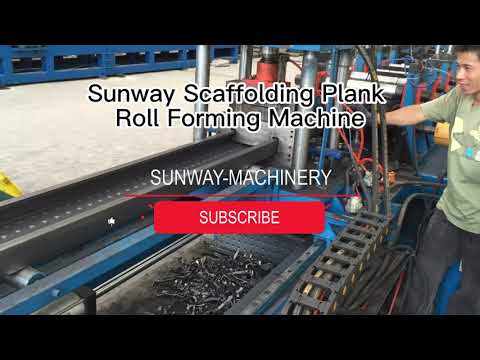
শীট মেটাল রোল ফর্মিং-এ সাধারণ চ্যালেঞ্জ এবং সমাধান
শীট মেটাল রোল ফর্মিং অসংখ্য সুবিধা প্রদান করে যদিও, প্রক্রিয়ার সময় উদ্ভূত হতে পারে এমন সম্ভাব্য চ্যালেঞ্জসমূহ সম্পর্কে সচেতন থাকা জরুরি। এখানে কিছু সাধারণ চ্যালেঞ্জ এবং তাদের সমাধান উল্লেখ করা হলো:
৮.১ উপাদানের ত্রুটি এবং অসামঞ্জস্যতা
শীট মেটালে ত্রুটি বা অসামঞ্জস্যতা থাকতে পারে যা রোল-ফর্মড প্রোফাইলের গুণমানকে প্রভাবিত করে। সঠিক উপাদান নির্বাচন, গুণমান নিয়ন্ত্রণ ব্যবস্থা এবং নিয়মিত পরিদর্শন এই সমস্যাগুলি न्यूনতম করতে সাহায্য করতে পারে।
৮.২ ফর্মিং এবং বিকৃতি সমস্যা
জটিল প্রোফাইল বা নির্দিষ্ট উপাদানের বৈশিষ্ট্য রোল ফর্মিং প্রক্রিয়ায় কাঙ্ক্ষিত আকার অর্জন এবং বিকৃতি এড়ানোর চ্যালেঞ্জ সৃষ্টি করতে পারে। টুলিং-এর সতর্কতার সাথে নকশা এবং মেশিন প্যারামিটারের সমন্বয় এই চ্যালেঞ্জগুলি অতিক্রম করে সঠিক ফর্মিং নিশ্চিত করতে পারে।
৮.৩ অ্যালাইনমেন্ট এবং মাত্রাগত নির্ভুলতা
ধাতুর শীটের অ্যালাইনমেন্ট ত্রুটি বা রোল ফর্মিং মেশিন সেটআপের অশুদ্ধি প্রোফাইলগুলিতে মাত্রাগত বিচ্যুতি সৃষ্টি করতে পারে। নিয়মিত ক্যালিব্রেশন, সুনির্দিষ্ট অ্যালাইনমেন্ট এবং পুঙ্খানুপুঙ্খ গুণমান পরীক্ষা এই সমস্যাগুলি সমাধান করে মাত্রাগত নির্ভুলতা বজায় রাখতে পারে।
৮.৪ টুলিং এবং ডাই রক্ষণাবেক্ষণ
রোল ফর্মিং টুলিং এবং ডাই-এর ক্ষয় এবং পরিধান প্রোফাইলের গুণমান এবং মেশিনের কর্মক্ষমতাকে প্রভাবিত করতে পারে। পরিষ্কার, লুব্রিকেশন এবং ক্ষতিগ্রস্ত উপাদান প্রতিস্থাপন সহ নিয়মিত রক্ষণাবেক্ষণ স্থির এবং দক্ষ অপারেশন নিশ্চিত করার জন্য অত্যাবশ্যক।
৮.৫ গুণমান নিয়ন্ত্রণ এবং পরিদর্শন
রোল-ফর্মড প্রোফাইলের কোনো ত্রুটি বা বিচ্যুতি শনাক্ত করার জন্য একটি শক্তিশালী গুণমান নিয়ন্ত্রণ ব্যবস্থা প্রয়োগ করা অপরিহার্য। নিয়মিত পরিদর্শন, মাত্রাগত পরীক্ষা এবং গুণমান মানদণ্ড মেনে চলা উচ্চ পণ্যের গুণমান এবং গ্রাহক সন্তুষ্টি বজায় রাখতে সাহায্য করতে পারে।
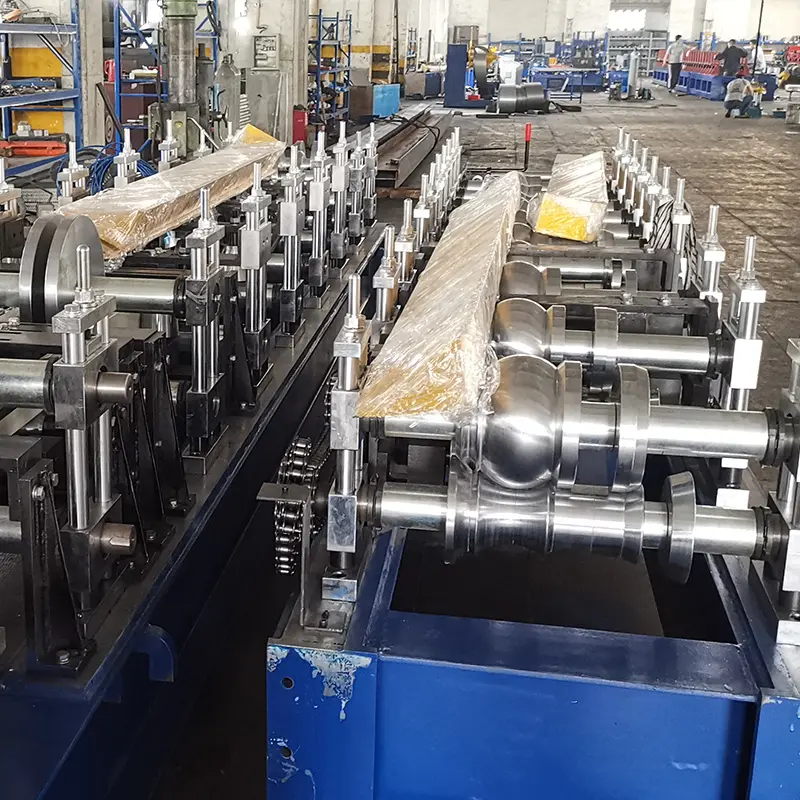
শীট মেটাল রোল ফর্মিং প্রযুক্তির ভবিষ্যৎ প্রবণতা
শীট মেটাল রোল ফর্মিং ক্ষেত্রটি প্রযুক্তিগত অগ্রগতি এবং শিল্পের চাহিদা দ্বারা চালিত হয়ে ক্রমাগত বিকশিত হচ্ছে। এখানে কিছু ভবিষ্যৎ প্রবণতা উল্লেখ করা হলো যা নজরে রাখা উচিত:
৯.১ উন্নত অটোমেশন এবং রোবটিক্স
অটোমেশন এবং রোবটিক্স ক্রমশই রোল ফর্মিং প্রক্রিয়ায় একীভূত হচ্ছে, যা উচ্চতর নির্ভুলতা, দক্ষতা এবং উৎপাদনশীলতা নিশ্চিত করছে। স্বয়ংক্রিয় উপাদান পরিচালনা, রোবোটিক টুলিং পরিবর্তন এবং রিয়েল-টাইম মনিটরিং সিস্টেম আধুনিক রোল ফর্মিং সেটআপে ক্রমশ প্রচলিত হয়ে উঠছে।
৯.২ ইন্ডাস্ট্রি ৪.০ প্রযুক্তির সাথে একীকরণ
শীট মেটাল রোল ফর্মিং মেশিনগুলি ডিজিটাল সিস্টেমের সাথে সংযুক্ত হচ্ছে, ইন্ডাস্ট্রি ৪.০ প্রযুক্তির সক্ষমতা ব্যবহার করে। ডেটা অ্যানালিটিক্স, ক্লাউড-ভিত্তিক প্ল্যাটফর্ম এবং স্মার্ট সেন্সরের সাথে একীকরণ রিয়েল-টাইম মনিটরিং, প্রেডিক্টিভ মেইনটেন্যান্স এবং উন্নত প্রক্রিয়া অপ্টিমাইজেশন নিশ্চিত করে।
৯.৩ হালকা এবং টেকসই উপাদান
টেকসইতার উপর ক্রমবর্ধমান গুরুত্বের সাথে রোল ফর্মিং প্রযুক্তি হালকা এবং পরিবেশবান্ধব উপাদান অন্তর্ভুক্ত করার জন্য অভিযোজিত হচ্ছে। এর মধ্যে উচ্চ-শক্তির মিশ্রধাতু, কম্পোজিট উপাদান এবং পুনর্ব্যবহারযোগ্য সাবস্ট্রেটের ব্যবহার অন্তর্ভুক্ত, যা শক্তি দক্ষতা প্রচার করে এবং পরিবেশগত প্রভাব কমায়।
৯.৪ উন্নত নির্ভুলতা এবং গুণমান নিয়ন্ত্রণ
সেন্সর, পরিমাপ সিস্টেম এবং নিয়ন্ত্রণ অ্যালগরিদমের অগ্রগতি রোল ফর্মিং প্রক্রিয়ায় উন্নত নির্ভুলতা এবং গুণমান নিয়ন্ত্রণ নিশ্চিত করে। গুরুত্বপূর্ণ প্যারামিটারের রিয়েল-টাইম মনিটরিং, ক্লোজড-লুপ ফিডব্যাক সিস্টেম এবং উন্নত পরিদর্শন কৌশল পণ্যের সামঞ্জস্যতা উন্নত করে এবং অপচয় কমায়।
৯.৫ উন্নত শক্তি দক্ষতা
শীট মেটাল রোল ফর্মিংয়ে শক্তি খরচ অপ্টিমাইজ করার জন্য বিভিন্ন প্রচেষ্টা চলছে। এর মধ্যে শক্তি-দক্ষ ড্রাইভ সিস্টেমের বিকাশ, বুদ্ধিমান পাওয়ার ম্যানেজমেন্ট এবং পুনর্নবীকরণযোগ্য শক্তির উৎসের ব্যবহার অন্তর্ভুক্ত। শক্তি-সাশ্রয়ী ব্যবস্থা শুধুমাত্র অপারেশনাল খরচ কমায় না, বরং উৎপাদন শিল্পে টেকসইতা প্রচার করে।

উপসংহার
শীট মেটাল রোল ফর্মিং মেশিন আধুনিক উৎপাদনে অপরিহার্য, যা দক্ষতা বৃদ্ধি, খরচ-কার্যকারিতা এবং বহুমুখী উৎপাদন সক্ষমতার মতো অসংখ্য সুবিধা প্রদান করে। ধাতব শীটকে জটিল প্রোফাইলে রূপান্তর করার ক্ষমতা নির্মাণ থেকে অটোমোটিভ শিল্প পর্যন্ত বিভিন্ন ক্ষেত্রে রোল ফর্মিংকে পছন্দের পছন্দ করে তোলে। রোল ফর্মিং মেশিনের মূল উপাদান, কার্যনীতি এবং প্রয়োগ বুঝে, উপাদানের পুরুত্ব এবং কাস্টমাইজেশন বিকল্পের মতো বিষয় বিবেচনা করে, উৎপাদকরা তাদের প্রয়োজন অনুসারে সঠিক মেশিন নির্বাচন করতে সচেতন সিদ্ধান্ত নিতে পারেন। রোল ফর্মিং কিছু চ্যালেঞ্জ উপস্থাপন করলেও, সঠিক রক্ষণাবেক্ষণ, গুণমান নিয়ন্ত্রণ এবং সেরা অনুশীলনের অনুসরণ এই বাধা অতিক্রম করে সফল উৎপাদন নিশ্চিত করতে পারে। ভবিষ্যতে, শীট মেটাল রোল ফর্মিং প্রযুক্তির সম্ভাবনা উন্নত অটোমেশন, ইন্ডাস্ট্রি ৪.০-এর সাথে একীকরণ, হালকা উপাদান, নির্ভুলতা উন্নয়ন এবং শক্তি দক্ষতার অগ্রগতির সাথে উত্তেজনাপূর্ণ।
প্রায়শই জিজ্ঞাসিত প্রশ্ন (এফএকিউ)
প্রশ্ন১. রোল ফর্মিং এবং স্ট্যাম্পিংয়ের মধ্যে পার্থক্য কী?
রোল ফর্মিং এবং স্ট্যাম্পিং উভয়ই ধাতু গঠন প্রক্রিয়া কিন্তু তাদের পদ্ধতিতে ভিন্নতা রয়েছে। রোল ফর্মিং একটি সিরিজ রোলার ব্যবহার করে অবিরত ধাতব শীটকে ধীরে ধীরে আকার দেয়, যেখানে স্ট্যাম্পিংয়ে ডাই ব্যবহার করে ধাতব শীটকে চাপ দেওয়া বা পাঞ্চ করে কাঙ্ক্ষিত আকার তৈরি করা হয়। রোল ফর্মিং সামঞ্জস্যপূর্ণ ক্রস-সেকশনের দীর্ঘ প্রোফাইল উৎপাদনের জন্য উপযুক্ত, যেখানে স্ট্যাম্পিং সাধারণত সমতল বা ত্রিমাত্রিক আকারের জটিল বিবরণের জন্য ব্যবহৃত হয়।
প্রশ্ন২. শীট মেটাল রোল ফর্মিং মেশিন কি বিভিন্ন ধরনের ধাতু পরিচালনা করতে পারে?
হ্যাঁ, শীট মেটাল রোল ফর্মিং মেশিনগুলি ইস্পাত, স্টেইনলেস স্টিল, অ্যালুমিনিয়াম, কপারসহ বিভিন্ন ধাতু পরিচালনা করতে পারে। রোল ফর্মিংয়ের জন্য কোনো নির্দিষ্ট ধাতুর উপযুক্ততা তার নমনীয়তা, পুরুত্ব এবং অন্যান্য উপাদানগত বৈশিষ্ট্যের উপর নির্ভর করে। উৎপাদকরা বিভিন্ন ধাতুর জন্য মেশিন প্যারামিটার এবং টুলিং সামঞ্জস্য করতে পারেন।
প্রশ্ন৩. শীট মেটাল রোল ফর্মিং মেশিনের সাধারণ গতি কত?
শীট মেটাল রোল ফর্মিং মেশিনের গতি প্রোফাইলের জটিলতা, উপাদানের পুরুত্ব এবং মেশিনের সক্ষমতার মতো বিষয়ের উপর নির্ভর করে পরিবর্তিত হতে পারে। সাধারণ গতি ১০ থেকে ১০০ ফুট প্রতি মিনিট (৩ থেকে ৩০ মিটার প্রতি মিনিট) হতে পারে। তবে, গতি উৎপাদন প্রক্রিয়ার নির্দিষ্ট প্রয়োজনীয়তা অনুসারে অপ্টিমাইজ করা উচিত যাতে গুণমান এবং নির্ভুলতা নিশ্চিত হয়।
কিউ৪. রোল-ফর্ম করা প্রোফাইলের গুণমান কীভাবে নিশ্চিত করা যায়?
রোল-ফর্মড প্রোফাইলের গুণমান নিশ্চিত করার জন্য কয়েকটি পদক্ষেপ গ্রহণ করা যেতে পারে। এর মধ্যে রয়েছে নিয়মিত পরিদর্শন, মাত্রাগত যাচাই এবং শিল্প মানদণ্ডের কঠোর পালন নিশ্চিতকারী একটি শক্তিশালী গুণমান নিয়ন্ত্রণ ব্যবস্থা প্রয়োগ করা। এছাড়াও, রোল ফর্মিং মেশিনের সঠিক রক্ষণাবেক্ষণ—যার মধ্যে পরিষ্কারকরণ, লুব্রিকেশন এবং টুলিং রক্ষণাবেক্ষণ অন্তর্ভুক্ত—অত্যন্ত জরুরি। উপকরণের কোনো ত্রুটি বা অসামঞ্জস্যতা পর্যবেক্ষণ করে সমাধান করা উচ্চমানের উৎপাদন বজায় রাখতে সহায়ক হয়।
প্রশ্ন ৫: রোল ফর্মিং কি একটি খরচ-কার্যকর উৎপাদন প্রক্রিয়া?
হ্যাঁ, রোল ফর্মিংকে বিশেষ করে বৃহৎ-পরিসর উৎপাদনের জন্য খরচ-কার্যকর উৎপাদন প্রক্রিয়া হিসেবে বিবেচনা করা হয়। এর স্বয়ংক্রিয় প্রকৃতি শ্রম খরচ কমায় এবং ওয়েল্ডিং বা রিভেটিংয়ের মতো গৌণ কাজের প্রয়োজনীয়তা দূর করে। উপকরণের দক্ষ ব্যবহার এবং ন্যূনতম বর্জ্য সহ জটিল প্রোফাইল উৎপাদনের ক্ষমতা খরচ সাশ্রয়ে আরও অবদান রাখে। তবে, রোল ফর্মিংয়ের খরচ-কার্যকরতা নির্দিষ্ট প্রকল্পের প্রয়োজনীয়তা এবং প্রত্যাশিত বিনিয়োগের প্রতিফল অনুসারে মূল্যায়ন করা উচিত।
Frequently Asked Questions (Supplemental)
1) Which materials and coatings run best on Sheet Metal Roll Forming Machines for exterior applications?
- Galvanized (ASTM A653), Zn-Al-Mg, and aluminum 3xxx/5xxx with PE/PVDF topcoats. Typical gauges: 0.35–1.2 mm. Use protective film for pre-painted coils and rolls with Ra ≤ 0.8 μm to minimize scuffing.
2) How can I improve first-pass yield on complex profiles with hems or interlocks?
- Use simulation-led pass design, document roll gaps per gauge, add laser length control, vision checks for flange height, and maintain tight entry guide alignment. Stabilize coil tension with a bridle before pass 1.
3) What cut-off system delivers the best accuracy at medium-to-high speeds?
- Servo-electric flying shear with high-resolution encoder feedback typically achieves ±0.5–0.8 mm at 25–40 m/min, outperforming conventional hydraulic-only setups in repeatability and energy use.
4) Can roll forming handle AHSS and stainless steel without edge cracking?
- Yes, with increased pass count, optimized bend progression, larger radii (≥1.5–2.0×t), appropriate roll materials (carbide/nitrided), lubricant management, and lower per-pass strain to control springback and micro-cracking.
5) What data should be captured for Industry 4.0 traceability?
- Coil certs (yield, thickness), pass setup (gaps, guide positions), line speed/tension, encoder counts, QC metrics (rib/hem height, width), tool life (cuts per blade), downtime codes, and maintenance logs.
2025 Industry Trends for Sheet Metal Roll Forming Machines
- Electrification and energy reduction: Servo-driven punches and shears with regenerative drives cut energy intensity by 10–20% vs. hydraulic-only lines.
- Faster, digital changeovers: Quick-change cassettes and recipe-driven presets reduce profile changeover to 20–45 minutes.
- Inline quality normalization: Laser length and vision-based geometry checks push FPY to 98–99% on painted profiles.
- Sustainability at scale: Shift toward Zn-Al-Mg coatings, recycled-content coils, and cool-roof paints; EPD-backed procurement is rising.
- Safety and compliance: Safety PLCs meeting ISO 13849-1 PL d/e and documented stop categories are baseline for CE/UKCA buyers.
Performance Benchmarks (General Roll Forming Lines, 2023 vs 2025)
| KPI | 2023 Typical | 2025 Best-in-Class | Key Enablers | Source |
|---|---|---|---|---|
| Changeover time (profile) | 90–180 min | 20–45 min | Quick-change cassettes, digital recipes | The Fabricator; OEM specs https://www.thefabricator.com |
| Length tolerance @30 m/min | ±1.2–1.8 mm | ±0.5–0.8 mm | Servo flying shear, high-res encoders | OEM datasheets |
| First-pass yield (painted) | 95–97% | 98–99% | Inline laser/vision SPC (ISO 22514) | ISO https://www.iso.org |
| Energy use (kWh/ton) | 120–150 | 95–120 | Servo actuators, regen drives | World Steel Association https://worldsteel.org |
| Unplanned downtime | 8–12% | 3–5% | PdM sensors, oil analysis, vibration | McKinsey PdM https://www.mckinsey.com |
Latest Research Cases
Case Study 1: Digital Recipe + Servo Shear Upgrade on Mixed-Material Profiles (2025)
Background: An appliance OEM formed galvanized and 304 SS profiles on a legacy line with frequent changeovers and scrap spikes.
Solution: Installed quick-change cassettes, servo-electric flying shear, laser length gauge, and MES-linked recipes auto-applying roll gaps and guides by coil cert.
Results: Changeover cut from 120 to 38 minutes; length tolerance improved from ±1.6 mm to ±0.7 mm; FPY rose from 96.2% to 99.0%; energy/ton reduced 13%.
Case Study 2: Zn-Al-Mg Adoption with Surface Preservation Protocol (2024)
Background: Building products maker shifted to Zn-Al-Mg for coastal projects but saw coating scuffs.
Solution: Nitrided/polished critical rolls, added felt wipers and UHMW-PE supports, enforced roll cleaning SOPs and protective film to exit.
Results: Coating defect rate dropped from 1.3% to 0.5%; warranty claims down 52%; throughput +11% with no quality loss.
Expert Opinions
- Dr. Alan Taub, Professor of Materials Science and Engineering, University of Michigan
Viewpoint: “Higher-strength and Zn-Al-Mg coated steels run reliably when pass progression limits strain per station and roll surfaces are controlled. Surface damage, not base-metal limits, is the top yield killer.” Source: https://mie.engin.umich.edu - Michael Kolisnyk, VP Engineering, Roll-Kraft
Viewpoint: “Documenting roll gaps and guide positions by gauge/coating and validating the first two passes can eliminate most downstream twist and bow issues.” Source: https://www.roll-kraft.com - Daniela Rossi, Functional Safety Lead, TÜV SÜD
Viewpoint: “ISO 13849-1 PL d/e with verified stop categories and interlock validation should be standard on new lines and retrofits—critical for CE/UKCA and real-world maintenance safety.” Source: https://www.tuvsud.com
Practical Tools and Resources
- COPRA RF (data M) – Roll forming simulation and pass design: https://www.datam.de
- Roll-Kraft Resource Center – Setup charts, troubleshooting guides: https://www.roll-kraft.com/roll-forming-resource-center
- The Fabricator – Best practices and case studies: https://www.thefabricator.com
- ISO Standards – ISO 13849-1 (functional safety), ISO 22514 (SPC): https://www.iso.org
- World Steel Association – Materials and energy benchmarks: https://worldsteel.org
- Keyence / Cognex – Laser length and vision inspection systems: https://www.keyence.com | https://www.cognex.com
Target keyword integration examples:
- Upgrading Sheet Metal Roll Forming Machines with servo flying shears and inline vision improves accuracy and reduces scrap.
- Preventive maintenance on Sheet Metal Roll Forming Machines—entry guides, roll tooling, and cut-off blades—stabilizes FPY and protects coatings.
- Industry 4.0 connectivity enables Sheet Metal Roll Forming Machines to log recipes, QC metrics, and coil data for end-to-end traceability.
Citations and further reading:
- The Fabricator: Roll forming fundamentals and modernization https://www.thefabricator.com
- World Steel Association: Energy and coated steel references https://worldsteel.org
- ISO: Functional safety and SPC frameworks https://www.iso.org
- McKinsey: Predictive maintenance and digital manufacturing https://www.mckinsey.com
Last updated: 2025-10-24
Changelog: Added 5 supplemental FAQs; 2025 trends with benchmark table; two recent case studies; expert viewpoints; curated tools/resources; integrated keyword examples and authoritative citations tailored to Sheet Metal Roll Forming Machines.
Next review date & triggers: 2026-05-20 or earlier if major OEMs release new quick-change cassette ecosystems, ISO 13849/22514 updates publish, or widespread adoption of Zn-Al-Mg/cool-roof coatings changes standard pass designs.
